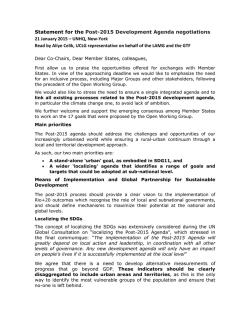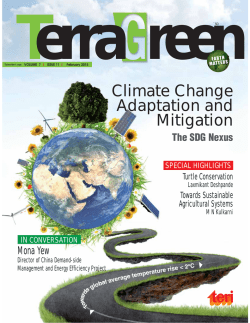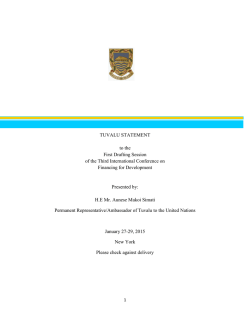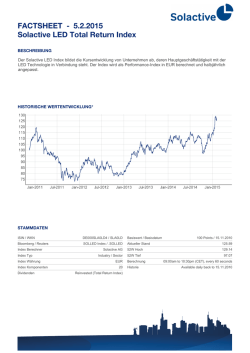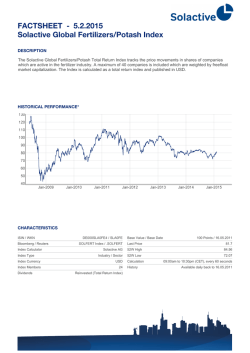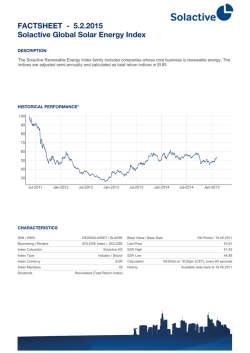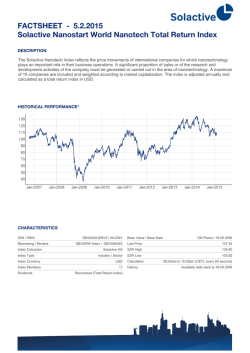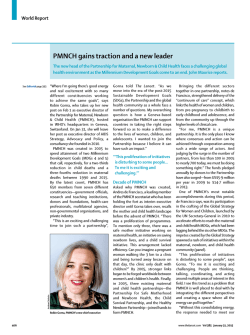
Towards Sustainable Development Goals
Towards Sustainable Development Goals: Essential Criteria IASS Discussion Paper1 Content (1) (2) (3) (4) (5) (6) The Context for this Paper 1 Key Aspect N°1: Create Visible Norms 2 Key Aspect N° 2: Identify Examples 5 Key Aspect N° 3: Differentiate Targets and Responsibilities 6 Key Aspect N° 4: Advance Equity and Well-being 8 Some Conclusions a. Selection and character of SDGs 10 b. Differentiation, measurability and transparency 11 (1) The Context for this Paper The Declaration “The future we want”, endorsed by the Rio+20 Summit in June 2012, and by the UN General Assembly in September of the same year, proposes a process of developing goals, targets and indicators for Sustainable Development, complementary to and coherent with the post-2015 MDG process.2 The SDGs themselves are to become “universally applicable” – an entirely new approach which differs from the traditional (and MDG) idea of dividing the world in “developed” and “developing countries”. They are expected to “address and incorporate in a balanced way all three dimensions of sustainable development and their interlinkages”3, i.e. they should not be perceived as merely “environmental” goals. This is the positive mandate for a necessary process this paper welcomes and aims at contributing to. Some proposals – starting with those of Colombia, Guatemala, Peru and the United Arab Emirates– are already on the table. To further the debate, IASS with additional financing from the German Ministry of Economic Cooperation and Development (BMZ) has hosted a dialogue process, consisting mainly of three events: (i) What do we need Sustainable Development Goals for? Latin American Perspectives. Public lecture, fireside chat and internal colloquium, with input presentations by ministry representatives from Colombia, Peru and Guatemala, and by scientists from Colombia and Brasil. Potsdam, 15/16 November, 2012. 1 As of 3 January 2013. For authorship, see footnote 5. It is not certain yet whether such “Sustainable Development Goals” (SDGs) will be endorsed by the UN General Assembly at all (this paper strongly advocates for it) and, if so, whether they will actually ‘merge’ with a new MDG set of goals. The paper does not define a position on how the final catalogue(s) should look like. They will, however, have to serve the common aim of securing environmental stability for development, and for re-defining development in terms of intra- and intergenerational justice. When the term “post-2015 agenda” or even “framework” is used in this text, we refer to this ideally common SD agenda, not necessarily to SDGs only. 3 UN The Future We Want, Resolution 66/288, (2012), §246. 2 1 (ii) Global Land and Soil Degradation. Dialogue Session as part of the First Global Soil Week. Berlin, 20/21 November, 2012. (iii) Sense (and Non-Sense) of a Sustainable Development Goal on Cities. Colloquium. Potsdam, 8 December, 2012. In addition to these three events – during which a preliminary version of this paper was discussed and commented by representatives from German and International academia, civil society and politics4 -, members of the IASS Research Clusters ”Global Contract for Sustainability” and “Sustainable Interactions with the Atmosphere” enriched the paper with useful comments, observations and suggestions. Although literal authorship of the present paper lies with Manuel Rivera5, all those contributions have been essential for its content. This paper will be structured along four key areas for the design of SDGs: visibility; exemplarity; differentiation; equity and well-being. In part [6], a few concrete suggestions for selection and measurement of SDGs deriving from these considerations will be listed. On the basis of the following arguments, the discussion paper concludes that SDGs a) have to be of a visionary and transformative character, b) should be outcome-oriented, not processoriented, c) should operationalize the dimension of equity in different ways, d) have to contribute a critical debate on the current paradigm of development and prosperity, e) should focus on global commons and “nexus” areas, f) need both common global and regionally differentiated targets, g) need to combine commonly accepted indicators with peer-reviews, and h) should rely on existing data and report systems but also close data gaps as soon as possible. Furthermore, the case for a land degradation neutrality target under the umbrella of a food security goal is made, and the importance of counting with proper Energy and Oceans goals is emphasised. It is recommended to consider Cities as a potential SDG topic. (2) Key Aspect N°1: Create Visible Norms Sustainable Development Goals may serve as a normative point of reference for actors and processes directly linked to them. This normative function, however, is equally important for other actors and processes, such as local SD initiatives and subnational policy strategies. Expectations can be shaped by establishing them. The support of the UN General Assembly is of high normative importance for this aim. Even if the SDGs were not satisfyingly met, they can serve the purpose of a ‘regulatory idea’. From this point of view, even goals in need of clear target development are worth supporting, as done for example by the European Commission with regard to the goal to achieve a land-degradation neutral world and the UNCCD Secretariat’s proposal on a “Zero Net Land Degradation” target.6 This emphasis on 4 The event series is documented in a separate report, available for download at the IASS Website. Sociologist, IASS Project Scientist since March 2011. [email protected]. Special acknowledgments go to Jörg Le Blanc for his support on content and organisation. 6 See UNCCD Zero Net Land Degradation. A Sustainable Development Goal for Rio+20, UNCCD Secretariat Policy Brief (2012). The proposal itself speaks about “Sustainable land use for all and by all” as a Goal (in agriculture, forestry, energy, urbanization), with Target 1: Zero Net Land Degradation by 2030, Target 2: Zero Net Forest Degradation by 2030, and Target 3: Drought Policies and Drought Preparedness implemented in all drought-prone regions/ countries by 2020. The target might seem to be not convincingly spelled out (yet): What does “zero” mean, for instance, with regard to possible global trade-offs between degradation in one region and restoration in another? 5 2 the normative dimension, however, must not be confused with overambition. We will come back to this issue in paragraph [3]. For serving the normative reference function, broad societal communication and dialogue on the SDGs is not only desirable, but indispensable. SDGs which are unknown to civil society (beyond the advocative dimension of internationally specialized NGOs), would neither work within a multi-level governance reality nor could they be truly transformative, given the necessary interpenetration of niches, regimes and landscapes. To unleash the potential transformative character of SDGs, i.e. their going beyond the mere extrapolation of already observable long-term trends, a broad, long term transdisciplinary dialogue is required.7 Furthermore, SDGs would highlight selected thematic areas in the public debate and make them visible. Generating a public debate on the reversal of unsustainable trends is fundamental to promote change and would be a major achievement in itself. Visibility is obviously pointed at by the Rio+20 outcome document’s statement that SDGs should be “easy to communicate”.8 This imposes the challenge of “address[ing] the complexity of development, yet exploit[ing] the charm of simplicity”.9 We have to acknowledge that any reduction of systemic complexity into goals will be only partly successful – a remark that might seem trivial at first sight, but carries implications for the design of the SDG system. An air of technical specialization, which inevitably surrounds ‘correct’ indicator formulas like UNDP’s Multidimensional Poverty Index (MPI) or WHO’s DisabilityAdjusted Life Year Index (DALY)10 might not go well along with the “easy to communicate” desideratum. Involuntarily, an over-sophistication of targets11 might contribute to the perception of the goals as addressing merely ‘technical’, instead of political problems. This being said, it seems to be preferable that SDGs would focus on the outcome rather than the process, as SDGs should be a point of reference for very different national and cultural realities, and for a multiplicity of political processes at different levels. Equally related to the hard slog of combining conceptual adequateness with visibility and political manageability, is the question of data. There were considerable gaps on several of the MDG indicators precisely regarding the most urgently addressed countries (LDC’s), 7 The German dialogue initiatives of the Sustainable Development Council (RNE) and others on the target “30 ha” (of daily national land consumption) offer good examples for such dialogue processes from the thematic area of soils. The fact that the target continues to be missed does not downgrade the process as such. A target which fails but stays within the reach of public consciousness might be frustrating – but a target which fails and is forgotten would have been meaningless. 8 UN The Future We Want, Resolution 66/288, (2012), §247. 9 Nicole Bates-Earner et al. Post-2015 Development Agenda: Goals, Targets and Indicators, Centre for International Governance Innovation (CIGI) and the Korean Development Institute (KDI), (2012), p. 6. The very refined CIGI/KDI proposal on a post-2015 goal system, though, is tending too much towards the complexity side, formulating issues like “environmental sustainability” or “global governance for realizing human potential” as single goals and therefore being in need for enormous lists of target and indicators. 10 On the complex discussion on indicators see Jeroen C.J.M. van den Bergh Abolishing GDP, Tinbergen Institute Discussion Paper TI 2007-019/3, (2007); Camilla Adele & Marc Pallemaerts Sustainable Development Indicators. An Overview of relevant Framework Programme funded research and identification of further needs in view of EU and international activities, European Commission, (2009); Justin M. Mog “Struggling with Sustainability - A Comparative Framework for Evaluating Sustainable Development Goals”, World Development, Vol. 32, No. 12, (2004), pp. 2139- 2160. 11 See the remarks on goals, targets and indicators in paragraph [4]. At this point, we just have to point out that, in the MDG case, the tangible, “visible” level was given mainly with quantitative targets (which necessarily bear close relation to indicators), not goals – an experience SDGs are expected to repeat. 3 showing significant statistic breaches and hampering comparability.12 Also, measures for gender equality or education quality were not satisfyingly conceptualized.13 The SDGs, if to be taken seriously, must avoid crude gaps between words and realities and face a dilemma: If there is no hard data, it might be difficult for political leaders to subscribe to SDGs during their political mandate; if we want precise targets on urban consumption or fuel poverty, on the other hand, no sufficient data might be available within a short time span. What is to be avoided, thus, is the reliance on insufficient data, on one hand, and a long lasting, obstructive data discussion, on the other. Internationally, mechanisms of data equalization exist and were strengthened, inter alia, through the MDG review reporting process itself.14 A call for concentration on the available15 is therefore the first thing needed – even more so if we consider that, generally speaking, many good targets have already been expressed in different conventions and COPs and should been taken up where appropriate. 16 Where we consider the available to be insufficient, we should clearly address the desirable anyway, calling for the rapid improvement of data. On the short run, also (available) proxy indicators could be used. The process of such improvement itself will fuel global “local to local” competition and dialogue, as has been shown by the MDG experience.17 Measurability – which IASS supports as an important element of SDGs – would to be understood, in this sense, as a process allowing for control and visibility, rather than a rigorous base of scientific evidence. It is an essential part of the way, not the point of departure. This is particularly true for the sub-national levels (e. g. cities) where the need for SDG monitoring could help to trigger accountability improvements through comparison and competition. 12 Andrew Sumner & Thomas Lawo The MDGs and Beyond: Pro-Poor Policy in a Changing World, European Association of Development Research and Training Institutes – EADI Policy Paper Series (2010), p. 7. Data often is not even uniformly available for one country. See F. Ram et al. Progress and Prospects of Millennium Development Goals in India, International Institute for Population Science (2009), p. 3-7. 13 See the examples provided by Barry Carin & Nicole Bates-Earner Post-2015 Goals, Targets and Indicators, CIGI Conference Report, Paris, (April 2012), p. 10, p. 16. 14 J. Waage et al. The Millennium Development Goals: a cross-sectoral analysis and principles for goal setting after 2015, The Lancet, Vol. 376, (18 Sep. 2010), pp. 991- 1023. 15 This bears relation to the political observation that, generally speaking, there has not been a lack of good targets so far, but a lack of implementation. The call for building on existent processes and frameworks, therefore, comes not only from th officials but also from civil society itself, e. g. at the 64 Annual United Nations DPI/NGO Conference “Sustainable Cities; Responsive Citizens”, Bonn, (3-5 Sep. 2011). 16 Just as an illustration, a few examples of existing ocean targets: - by 2015 to maintain or restore stocks to levels that can produce maximum sustainable yield on an urgent basis; to eliminate illegal, unreported and unregulated fishing etc. (Johannesburg Plan of Implementation); - by 2020 10% of coastal and marine areas, especially areas of particular importance for biodiversity and ecosystem services, are to be conserved through effectively and equitably managed, ecologically representative and well-connected systems of protected areas and other effective area-based conservation measures (CBD Decision X/2, Aichi Targets); - to achieve or maintain good environmental status in the marine environment by the year 2020 at the latest (EU Marine Strategy). 17 Birgit Lode “SDGs: A Renewed Commitment to Implement Existing and Emerging Sustainable Development Goals?”, in M. Beisheim et al., UNCSD Rio 2012. Twenty Years of Sustainability Policies – Now Put into Practice?, SWP Research Paper 2012/RP08, (June 2012). 4 (3) Key Aspect N° 2: Identify Examples Societal dialogue, as said before, imposes limits to complexity. Governments and stakeholders should be aware that SDGs have to reduce complexity and therefore to simplify many sustainability issues. Such (over)simplification is by no means ‘bad’, as long as the target or the indicator is not mistaken for the issue it represents.18 An interesting question is whether such representation should occur in a comprehensive or rather in an exemplary way. This also, and even more importantly so, applies to the selection of goals and their thematic areas with regard to ‘overall sustainability’. The comprehensive option would see an SDG catalogue not only building on the original text of the Agenda 21 and the Millennium Declaration – and this means inter alia, to include explicitly the peace and stability, as well as the democracy dimension – but, above all, trying to draw a systemic picture of sustainability, i.e. cover all planetary boundaries and global commons like climate stability and biodiversity, while at the same time integrating all of them with socio-economic development.19 In political reality, there are several groups advocating for their particular goal or theme - private sector, climate, health, etc. as no one understandably wants to be left out. Then again, the Secretary-General’s High-Level Panel of Eminent Persons on the Post-2015 Development Agenda and the Open Working Group for the SDGs will need to prioritize, while at the same time clearly justifying their selective decisions in a way that keeps all stakeholders on board, which will present a big challenge for these two groups. Answering the challenge with an ‘allencompassing’ agenda, would satisfy nobody, though, and visibility (see [1]) would be watered down considerably: If everything is a goal, nothing is. A ‘messianic’ overburdening of the post-2015 process – finding solutions for everything – is to be avoided20. While chapter III (poverty) of the Millennium Declaration should be kept as the spine of SDGs and complemented by chapters IV (environment) and until certain extent V (governance), the huge chapter II (peace and disarmament) seems to exceed the possibilities of SDGs and would claim for a separate set of goals21 - if sanctionless UN goals form the right medium to address these issues at all. On the other hand, environmental issues where treaty mechanisms are already in place, like the climate and biodiversity conventions, might be better off without interference of a post-2015 development framework. 18 As happened, for instance, with the confusion of the MDG 1 target formulation “halving” income poverty with the goal ambition of “eradicating” it, and, even more so, with the one dollar income threshold with “poverty” as such. 19 This idea is expressed in Oxfam’s Idea of a “safe and just space for humanity”, see Kate Raworth A safe and just space for humanity. Can we live within the doughnut?, Oxfam Discussion Paper, (2012). 20 and pragmatically restrained by the already mentioned § 247 of the “The Future we want”-Document which sustains that goals should be “easy to communicate and limited in number”. Even if the outcome of the next two years is a double set of goals (MDGs+ and SDGs; a design not considered desirable my many), the number of eight ‘new’ goals will and should not be surpassed. 21 as pushed by fragile states themselves (g7+)in the shape of “Peace and Statebuilding Goals” (PSGs), see http://www.newdeal4peace.org/psg , web-page accessed 20. Dec. 2012 . Interestingly, when coming to the “economic foundations” of conflicts – the so called PSG 4 – indicators boil down to measurements like the ratio of natural resource production of a country to total revenues to government or income inequality among regions (IDPS Working Group Progress Report on Fragility Assessments and Indicators, http://www.newdeal4peace.org/wordpress/wpcontent/uploads/progress-report-on-fa-and-indicators-en.pdf, web-page accessed 13 Dec. 2012, p. 15s). Such an indicator would be perfectly fitting under SD Resource or Equity Goals – Goals that might be more helpful, within the context of SDGs, to the aim of peace, than Justice or Security Goals themselves. 5 When these arguments are taken into consideration, the option of exemplarity gains appeal. Exemplarity can be understood as a way of representing sustainability without signifying it exactly. One way to do this would be implication. A goal on “Sustainable Cities”, for instance, which comprises ambitious waste reduction and transport targets, could address the internalisation of externalities, resource efficiency, equity and sociotechnical innovation, all at once – without explicitly providing individual targets for each of these dimensions.22 Exemplarity can also be understood as representing a significant detail or part of a bigger complex: for example, the governance challenge to recognize high seas ecosystems as part of a global common or the marine fish stocks as ‘part of’ global biodiversity. In a similar vein, each of the three objectives of the UN Secretary General’s Sustainable Energy for All initiative23 already comes a long way towards an SDG on Energy, exemplifying (but not exhaustively encompassing) the transformation towards a sustainable energy system. Even highly sensitive issues like “population” (control) could be addressed in an exemplary way at the target level, e. g. by comprising better education of teenagers (under an SDG on Education) and indicators for reproductive health. Such exemplarity would serve both the Rio+20 outcome document’s call for priority setting and the visibility aspect we referred to in paragraph [2]. Both functions – political opportunity and visibility – are valid criteria for selection. To answer the criticism that exemplarity can equal political ‘arbitrariness’, though, a more rigorous third selective criterion is needed. In our view, this would be the transformative potential an SDG has to show. We will come back in paragraph [5] to this aspect. But first, a few more words have to be said on political opportunity, especially on the ownership and applicability at national and regional levels. (4) Key Aspect N° 3: Differentiate Targets and Responsibilities National ownership for SDGs will be facilitated once and if the target and indicator levels live up to the Rio principle of common but differentiated responsibilities (CBDR). 24 With regard to global commons, interesting operationalization ideas beyond the “annex 1” regula22 Reducing the geographies of extraction and environmental damage caused by urban consumption means dealing with their root-causes in the cities themselves (for instance by closing resource cycles) and internalising the externalities which are often shifted to different countries then blamed for increased emissions and environmental damage. This shift will mean that there is a lot of work to do for ‚Northern’ countries to get their resource flows sorted out in urban areas. It also calls for urban systems transitions and life-style changes. This would avoid problem offsetting as observed for instance in the carbon credit scheme. 23 (1) Universal access to modern energy services (2) doubling the global rate of improvement in energy efficiency, (3) doubling the share of renewables in the global energy mix. See www.sustainableenergyforall.org, web-page accessed 20. Dec. 2012. Also the time horizon would be the same one envisioned for SDGs (2030). 24 This principle is N° 7 of the declaration and reads: “States shall co-operate in a spirit of global partnership to conserve, protect and restore the health and integrity of the Earth's ecosystem. In view of the different contributions to global environmental degradation, States have common but differentiated responsibilities. The developed countries acknowledge the responsibility that they bear in the international pursuit of sustainable development in view of the pressures their societies place on the global environment and of the technologies and financial resources they command.” See UNCED The Rio Declaration on Environment and Development, (1992). It has been especially mentioned and reaffirmed by The future we want UN (2012), § 15 6 tion of UNFCCC already exist25 and it will be challenging to develop similar burden sharing approaches for other thematic areas, such as for an Oceans SDG. But the SDG momentum might even be more pronounced in thematic areas where SD problems are ubiquitous, but not global in the sense of common target values to be expected or even desirable. This is the case of fertile soils: located in one particular territory, they need to be protected and sustainably managed on site. Nutritious or healthy food, a globally applicable SDG, will need to deal with the problem of hunger in some countries, and with obesity in others. And, to give just a third random example, even a global target like “universal access to modern energy services” will have to be operationalized through different indicators, e.g. households without electricity in poorer countries and percentage of household income spent on fuel and electricity in societies with a more advanced infrastructure. This CBDR-related sensitivity to different social and political realities could constitute a major momentum of SDGs. This, however, requires to establish a sufficiently ‘open’ catalogue of goals and targets which allows for regional differentiation and an intelligently tailored review mechanism which goes beyond mere bottom-up reporting as well. Peer review approaches (like, e.g., the one currently carried out for the second time with regard to the German National SD Strategy26) might be a helpful ingredient of a post-2015 implementation framework27, because they can account for different policy challenges, indicator differentiations and the specific gaps in data and their further development. An intelligent review mechanism could also help to ground SDGs in the respective political realities and to make them a societal topic. The time for “one-size-fits-all” tailored targets is over – universal application of goals is in need of a sound subsidiarity principle. The MDG experience, that progress on many of them has been reached by certain regional (growth-based) advances e. g. in East Asia, not really illustrating worldwide developments, or, on the other hand, that progress in e. g. Africa has not been shown fully by the numeric standards of the Millennium targets 28, should not be repeated. A new set of goals will have the task and responsibility to reflect different realities and responsibilities and make them transparent. This transparency, as elaborated already in paragraph [2], is not just an add-on, but a necessary condition for the success of the framework. With regard to measurement, this transparency needs to be ensured within the very text and details of an SDG catalogue; if necessary, even at the target level itself (e. g. under thematic goals where indicator gaps are apparent). Sustainable Development Goals will say what is important to do; indicators will determine how we perceive this task, and targets will set the level of ambition.29 It is at the target level where differentiation will be most needed. While we certainly will need some global 25 For instance climate issues are addressed in the Greenhouse Rights Development Framework that has been developed jointly by SEI, Böll Foundation and others. Peter Baer et al. “Greenhouse Development Rights: towards an equitable framework for global climate policy”, Cambridge Review of International Affairs, Vol. 21, No. 4, (2008), pages 649-666. 26 See press releases and first review document on http://www.nachhaltigkeitsrat.de/en/press-information/pressrelease/peer-review-22-10-2012/?size=2amp%3Bbls, web-page accessed 6. Nov. 2011. 27 In this regard see also the suggestion brought forward by Marianne Beisheim Post-2015 Development Goals: UN Negotiations Begin, SWP Comments 2012/C 36, (2012), p. 4. 28 This has been admitted officially by the UN themselves. See UN The Millennium Development Goals Report 2012, (2012), p. 6s. 29 Cf. Bates-Earner Post-2015 Development Agenda (2012), p. 5. The CIGI work on these aspects is of great value both regarding the concept and indicator examples. 7 targets as well – regarding for instance the overall improvement rate of energy efficiency, or land degradation neutrality – in many cases countries will need to set up their own priority ambitions, be it for instance sector targets in the energy sector or specific soil restoration targets in different areas. Many possible thematic areas for formulating differentiated targets can be mentioned, such as of food or gender (primary school enrolment of girls vs. rate of women in leading business positions). As it is crucial that countries with similar targets are comparable within the framework, they should draw their indicators from a commonly agreed basket of indicators, to which the general recommendations outlined in paragraph [2] should apply. Sensitivity for national realities, furthermore, induces reservations with regard to a “rights based approach”. SDGs will probably not constitute a new Human Rights Declaration (with follow-up implications like a specialized international court, the “responsibility to protect” etc., which took to develop decades since 1948); their strength lies elsewhere. Second, the “regulative” normativity, although very much in the need of addressing intra- and international distributive justice, should not be linked too closely, in the case of SDGs, to individual-rights-based approaches. This can lead to heavy contradictions30 and therefore either put rights in the danger of becoming a rhetoric add-on with no accountability mechanisms attached to it31, or, when taken seriously, exacerbate the political problem of the (non)binding character of goals and their ‘enforcement’ to an unnecessary degree. The concept is already misused for ideas like the ‘right to pollute’. Instead of aiming at the status of rights, SDGs might be better off with a character of desirability. That is so, because a rights based approach implies on the side of accountable duty bearers (states) obligations in the strongest sense, hampering achieving an agreement. Nonetheless, credible commitments at nation-state level are needed to secure the normative frame of reference for financial means and political measures. (5) Key Aspect N° 4: Advance Equity and Well-being In all of the different realities and processes, though, SDGs will have to refer to, the “fundamental principle”32 of equity. Equity as fairness regarding chances33 can help to push the development agenda beyond the fulfilment of basic needs, addressing poverty34 and 30 Like it did in the case of the idea of a universal right to food. This idea was promoted by several institutions, among them the FAO, for many years and is implicitly reflected in the MDG 1 title “eradicate hunger” – but then operationalized in the comparatively meagre target of “halving” hunger until 2015, a target which then is not even met in Sub-Saharan Africa and Southern Asia; cf. UN The Millennium Development Goals Report 2012, (2012), p.12. 31 A. Cornwall & C. Nyamu-Musembi „Putting the ‚rights-based approach to development into perspective“, Third World Quarterly, Vol. 25, No. 8 (2004), pp. 1415-1437, esp. p. 1432 s. 32 as which it is regarded, along with Human Rights (maybe problematic; see above) and Sustainability, by the UN System Task Team on the Post-2015 UN Development Agenda. See UNTT Realizing the Future We Want for All. Report to the Secretary General, New York, (2012), p. 23. The term “equality”, however, runs the risk to put too much emphasis on the quantity, instead of adequateness of outcomes. 33 Which equals social justice in such different thinkers as John Rawls, Amartya Sen or Nancy Fraser. 34 In richer countries, relative poverty (e.g. referring to an accumulated income less than 60% of the median equivalised disposable income), which is ultimately a distributive concept, is already used to define national poverty thresholds. 8 well-being questions in ‘developed’ countries as well (see [6]). The often formulated critique on the Millennium Development Goals (MDGs), that they have framed poverty in terms of mere survival and not accounted for exclusion nor capability deprivation, will have to be translated into a new set of inventive targets and indicators. Another aspect in which the MDGs fell short is the multi-dimensional character of the goals. If the SDGs are to effectively consider equity and sustainability, they will have to consider a DNA-like structure to balance social, economic and environmental aspects within each goal. This, however, is easier said than done. One approach is taking care of access-equalities in each of the thematic areas (i. e. freshwater, fertile soils35, modern energy services36). An additional approach, in our opinion, would be to further develop the MDG education goal (considering that education is the equity ‘enabler’ par excellence) and extend that goal’s inclusive aim towards a political participation target. Specialized distributive indicators37 may have the advantage of allowing for comparisons, but are not easy to communicate (“is ‘0,7’ good or bad?”). The generalized claim to disaggregate all capita-related data by gender, age and geography (including urbanrural)38, points in the right direction. If this was extended to, for instance, income quintiles, a fuller realization of the notion of intragenerational justice (which, in a tension with intergenerational considerations, lies at the heart of the sustainability concept39) could be achieved. The side-effect of combining sustainability and traditions of social accounting – which quantile measurements are an inherent part of –, might be a further popularisation of SDGs The equity dimension, additionally, is close to the question of redefining prosperity. There is a momentum for SDGs to challenge and problematize the development discourse – thus making use of their global character. As a whole, they should challenge the perception of ‘northern’ countries as “being developed”. This would be a discursive end in itself, opening new opportunities.40 Platforms which intend to work as knowledge brokers and process facilitators in a public, transparent way, may help to promote such discourses within their thematic areas.41 Apart from these ‘issue driven’ areas, the debate could even extend towards questions of wealth and life quality and contribute – as a normative reference point, again – to the various critiques on the GDP as an indicator for welfare. Again, for the socalled developed countries, the challenges in e. g. consumption are enormous and could 35 In the case of land and soil in ‘developing’ countries, privileged access to fertile soils by some, combined with their economic and political influence, lets others remain landless or with limited access. 36 Done not only in the context of the already mentioned Sustainable Energy for All Initiative, but also for the World Energy Council’s Energy Sustainabilty Index which gives access to electricity as part of “social equity” a weight of 1/6 of the overall energy performance. See World Energy Council World Energy Trilemma. 2012 Energy Sustainability Index, London, (2012), p. 116. The other equity indicator is “affordability”. The indicator, however, is unsatisfactorily measured as a price in Dollar per kWh. 37 Like the Gini-Index, which can easily be applied to more than income (e. g. to assets or estates). 38 Most prominently in UNTT Realizing the Future We Want for All, (2012), p. 8 (§26). 39 See Oluf Langhelle “Sustainable Development and Social Justice: Expanding the Rawlsian Framework of Global Justice”, Environmental Values, Vol. 9, No. 3, (2000), pp. 295-323. The equity claim, therefore, does not just stem from the MDGth ‘Thread’ of post-2015 thinking, but from the Rio-Thread as well. See also the “disparities” formulation in the 5 Rio Principle, see UNCED The Rio Declaration on Environment and Development, (1992). 40 Societal discussions of visions („Leitbilder“) have seldom enough blossomed when initiated top-down; but even the interesting bottom-up initiatives in that direction, like „Zukunftsfähiges Deutschland“ in Germany, have not made it beyond certain civil society ‘niches’. In order to access the ‘landscape’ level, SDGs might provide a new opportunity for this kind of visions. 41 As in the case of the IASS initiatives “Global Soil Forum” and “Transdisciplinary Panel on Energy Change”. 9 possibly address even remote issues like working hour reduction, seldom touched in the conventional SD context.42 With regard to the distribution of resource use, the equity dimension here, ideally, would often take the shape of per capita targets – an approach to be kept in mind despite its political contentiousness. The aforementioned momentum for inserting aspects of a redefinition of prosperity into a post-2015 framework has probably been triggered by the World Financial Crisis and has led to several reports and initiatives on well-being measurement43, which have to be taken into consideration when defining Sustainable Development goals, targets and indicators. This discussion paper is not taking a position on whether, for instance, the numerous subjective elements in “Gross National Happiness” are methodologically reliable and valid 44 - it just draws attention to the fact that such attempts to modify the “growth and jobs” based model are ever more needed, to decrease the pressure that a growth based model exerts on the planet. With regard to “happiness”, though, the only thing that is certain when having a look at classic and modern economics, is the close correlation of perceived equity within a nation, and the contentment of citizens.45 Moreover, this would possibly be the only element of happiness directly sensitive to political steering. Fairness and equity, therefore, will have to play a key role when defining the post-2015 framework. (6) Some Conclusions Building on the arguments put forward in this paper, it seems safe to give a few recommendations on structure, criteria and partly content of SDGs. (a) Selection and character of SDGs Bold and visionary SDGs are at least as important as ‘feasible’ ones, when discussing the catalogue. They should show potential to fuel public debate beyond already engaged experts. At least some of them should contain transformative targets and counter current unsustainable trends. Goals have to be comprehensive, paying attention to all three dimensions of SD. The previous paragraph makes the exemplary case for aiming at a land degradation neutral world within the set of SDGs. This will convey the message 42 Cf. Mohan Munasinghe “Millennium Consumption Goals (MCG): How the rich can make the planet more sustainable,” The Island Online, (2011), www.island.lk/index.php?page_cat=article-details&page=article-details&code_title=17248, webpage accessed 6. Nov. 2012. See also the table of proposed goals and targets at http://www.mcgforum.org/wpcontent/uploads/2011/08/Table-MCG-Summary-v2.pdf , web-page accessed 6. Nov. 2012. 43 Namely the so-called Stiglitz-Sen-Fitoussi Commission’s report to the French Government, and, currently the Bhutanese Initiative “Wellbeing and Happiness: Defining a new Economic Paradigm”. It is remarkable that this initiative is nurtured by the expertise of leading experts and is explicitly encouraged by the UN General Assembly “to share information thereon with the Secretary-General as a contribution to the United Nations development agenda, including the Millennium Development Goals”, see UN Happiness: towards a holistic approach to development, Resolution 65/309, (July 2011). 44 For a critical review of GNH, see Winton Bates “Gross National Happiness”, Asian-Pacific Economic Literature, Vol. 23, No. 2, (2009), pp. 1-16. 45 For a review, see Phillip Lepenies Happiness and Inequality. Insights into a Difficult Relationship – and Possible Political Implications, desiguALdades.net Working Paper Series, (2012). 10 that, while land degradation cannot be totally avoided, its negative impacts can be “offset” at the local level by restoring degraded or unproductive soils and land. Achieving land degradation neutrality entails a clear environmental aim but it also has social and economic implications as it relates to achieving food security and reducing poverty. With regard to the overall post-2015 framework and the notion of “environment for development” in mind, a target on land degradation neutrality under a Food Security Goal seems to be a recommendable option. Political opportunity should be taken into consideration. SDGs should not be formulated for areas where heavily burdened treaty processes are already in place. SDGs seem not the right frame for detailed process prescriptions either; nation states should discuss and find their own ways to achieve them. This applies to the issue of peace and stability, as well. A separate goal for this area is not recommended. Equity must be taken seriously as a dimension for SDGs. This could imply a differentiated treatment of “access” categories throughout thematic areas along the lines of social accounting, and emphasis on participation and education targets.46 Empowerment for socio-economic and political participation has to be promoted. The link between equity and alternative well-being indicators needs to be paid attention to. Happiness, if measurable adequately, could be taken into consideration. A broad discussion on the current paradigms of development and prosperity is required. Global commons, when not hampered by the aforementioned ‘overlap’ of international processes, should find a place among SDGs. Oceans seem to be a perfect candidate for such a goal. The selection of thematic areas should be guided by the potential for action, visibility and cross-sector inter-linkages. This puts both Cities and Resource Use on the forefront. (b) Differentiation, measurability and transparency Goal formulations must address globally desirable outcomes (the normative consensus) but define them in a way that permits regionally and nationally differen- 46 For instance, the very basic MDG 2 could be further developed into an SDG “Active, inclusive and literate citizenship”. This SDG would need to include targets not only for (a) school enrolment, but also for (b) literacy/functional literacy, and (c) political participation, the latter allowing particularly well for culturally diverse operationalisations. Indicators for nonviolent, active citizenship participation in institutions and formalised processes already exist and can be used and further developed into a measurement of political active citizenship. See Marga de Weerd et al. Indicators for Monitoring Active Citizenship and Citizenship Education – Final Report, Regioplan Beleidsonderzoek, Research Report for the European Commission/DG EAC, (2005). See also OSCE High Commissioner on National Minorities The Lund Recommendations on the Effective Participation of National Minorities in Public Life & Explanatory Note, (1999). 11 tiated, even diverging targets.47 Goals, targets and indicators have to be meaningful at the local level. Therefore, the targets for SDGs must count on an intelligently tailored “pledge and review system” with peer pressure, which allows for the representation of differentiated regional realities within the frame of reference provided by the goals.48 In order to soften the latent tension between differentiation and accountability, nation states might choose for their targets from a globally agreed basket of indicators to ensure comparability and adaptation to local situations. Combining numerical targets and peer-reviews will help to bring adaptation to local challenges and comparability together. Simple numeric target and threshold values should, on the whole, be preferred over indices when operationalizing SDGs. Already existing report systems or indicators should be taken up; where they prove to be insufficient, necessary data collection steps should be addressed early and clearly. Not all of the targets should be differentiated; examples for the usefulness of global targets can be found, for example, in the areas of Energy and Oceans. The aspect of transparency in data and indicators in itself is a ‘target’ to be agreed on and to be ensured via procedural standards. 47 Examples for this can already be found in the Colombian-Peruvian Concept Note for Rio+20, like “reduction in food waste and food losses” or “improved resource productivity in cities”. These are meaningfully applicable to very different realities. (Basically: When one says “food”, one has to address hunger, but also obesity; when one says “poverty”, one has to address excessive affluence as well.) 48 The Open Method of Coordination (OMC) that is currently used to coordinate policies among European countries can offer an example for organising peer-reviews. The OMC is a voluntary process based on common objectives and indicators. Peer-reviews of national practices identify and disseminate best practices, promoting a mutual learning process. Although the process might not work as smoothly in practice, it can offer some interesting ideas for envisioning a global peer-review based monitoring system. 12
© Copyright 2025
